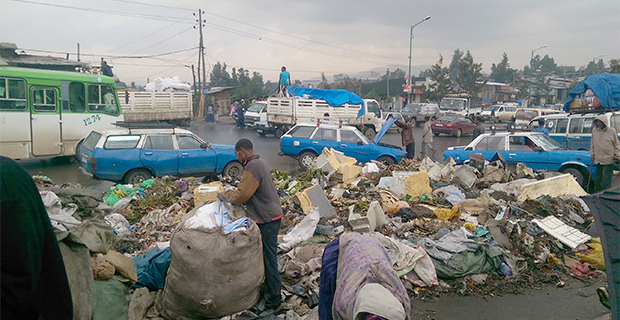Ethiopia: Addis Abeba’s solid waste has now been piling-up across neighbourhoods in the city for the past 10 days, after the Sanitation Administration Agency failed to pick up the capital’s trash.
Farmers in Berke Wereda, Oromia Special Zone, where Sendafa Landfill, the new waste disposal and recycling centre of the city, is located, refuse to allow garbage to be dumped in the area.
Sendafa Landfill, which was built by VINCI Grands Projets, a French construction company, with over 337 million Br, rests on 137ha of land. It is designed to provide waste management services for over 3.5 million residents of the capital and 195,255 residents of the Oromia special zones, particularly – Sululta, Lege Tafo, Burayu, Sebeta and Gelan.
On average, a person in Addis Abeba generates 2.1 cubic metres of trash a day. The city’s government plans to collect over 3.1 million cubic metres a year.
Back in 2014, when the municipality had just completed the feasibility study, the Solid Waste Recycling and Disposal project Office’s (RDPO) communications head, Tsegaye Hailu, toldFortune that the farmers were relocated from the area after being paid 25 million Br in compensation, taking into consideration the 10-year potential output of their farms.
However, farmers who live nearby the landfill are blocking the disposal of any trash collected from the city, according to the Agency.
Sendafa was chosen as a replacement for the 50-year-old Rappi dumping ground – a 25ha landfill commonly known as Koshe. This former landfill was deemed by the Addis Abeba City Solid Waste Management system as no longer viable, eluding to the lack of fence, odour or vector control, weigh bridge and daily cover of soil. The site had up to 300 waste pickers a day, while having the high potential for nuisance and health hazard for people living nearby.
The new landfill, which has a life expectancy of three decades, has a fence, 9.5km of asphalt road, a weigh bridge and four transformation sites: Reppi, Akaki, Filidero and Bole Arabsa. These areas are now being considered by the Agency as alternative sites for the city’s garbage.
The Agency’s 610 small primary garbage collecting micro and small enterprises, with a total of 6,500 members, have not been providing their usual door-to-door services to over 500,000 households in the city. The other disposal method offered by the Agency, garbage dumpsters, had over a thousand completely full with more trash thrown all around them.
“It has been two weeks since any garbage collector enterprise reached our doors; we pay 400Br for two days for garbage collectors who we do not know,” said Kassahun Fekad, manager of the Abesha Bar & Restaurant located on Debrezeit Road – a place commonly known as Adey Abeba.
A janitor who works in a hotel on Gabon St also had concerns about the city’s garbage collection.
“The price of these unknown garbage collectors is overrated and God knows where they will be dumping all that trash they take from our gates,” he said. “That is of course if you are lucky enough to get one of them to turn up.”
Though the Sandafa Landfill was reported to recycle 1,200 tonnes of solid waste every day, 70pc of the city’s garbage goes to the dump. The Agency’s report during the current fiscal year stated that 60pc of solid waste is biodegradable, while the rest cannot be recycled.
Another resident of the city, Worknesh Melkamu, a housewife in her early 50s, told Fortune that the situation is really disturbing.
“The hospitals and clinics all over the city are teaching people to stay sanitary to avoid Cholera, while the city is unable to collect its garbage,” She said firmly. “I am afraid to let my grandchildren go out and play, since there is no clean place.”
Households make up 82pc of the total 3,028 tonnes of solid waste generated in Addis Abeba.
![]()






























